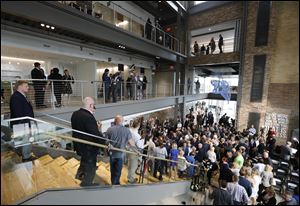
EDITORIAL
Keep Historic Tax Credit
11/15/2017
The GOP has begun negotiating a plan for comprehensive tax reform, and one of its chief objectives is simplifying the Byzantine system of rewards and incentives. No doubt the economy would benefit from a streamlined code, but legislators should be careful not to ax those tax credits whose fiscal and social benefits are beyond dispute. There are few clearer examples than the federal Historic Tax Credit.

People tour the new ProMedica headquarters during the grand opening of the facility in downtown Toledo. The headquarters is among the Toledo area projects made possible in part by historic preservation tax credits.
Click here to view more Blade editorials
Congress passed the HTC in 1976 to encourage private investment in projects to rehabilitate historic buildings, including vacant schools, warehouses, factories, retail stores, apartments, hotels, and office buildings throughout America. The HTC provides a 20 percent credit for the rehabilitation of historical buildings and a 10 percent credit for nonhistoric buildings placed in service before 1936.
Since its implementation, the HTC generated more than $29.9 billion in federal tax revenue, or a return of $1.20 on each dollar in tax credits awarded, according to data collected by the Rutgers Center for Urban Policy Research. Paired with Ohio’s own historic tax credits, the return rises to $6.20 in taxes generated for every dollar the state forgoes through its tax credit.
Without the incentives created by this program, important historic rehabilitation projects cannot get off the ground, owing to higher costs, design challenges, and weaker market locations. For Toledoans, the arguments for keeping this tax credit are all around them. ProMedica’s corporate headquarters and Hensville are some of the largest investments made possible by historic preservation tax credits. The Fiberglas Tower — now called the Tower on the Maumee — and the Berdan Building would likely still be vacant without the subsidies. There are numerous other success stories. And Toledo’s rich and varied stock of historic buildings means potentially many more.
Ending the historic tax credit program would threaten Toledo’s momentum, and its future.